 SVJP-0335.2021 |
-
 Artist: Utagawa Kunisada [歌川 国貞] a.k.a. Utagawa Toyokuni III [三代歌川豊国] (Japanese, 1786 – 1865). Signed: Ichiyōsai Toyokuni hitsu [一陽斎豊国筆]. Inscriptions: [松竹梅] Shochikubai = pine (matsu, 松), bamboo (take, 竹), and plum (ume, 梅) – an auspicious grouping known as “The Three Friends of Winter“; [三福追] (Sanpuku tsui) – the three delights, or pleasures. Date seal and aratame censor seal: Ansei 2, 1st month (1855). Publisher: Ibaya Senzaburō [伊場屋仙三郎] (Japanese, c. 1815 – 1869). Block carver: Yokokawa Takejirō [横川竹二郎] (Japanese, fl. 1845 – 1863); seal: Hori Take [彫竹]. Kabuki actor Onoe Kikugorō V [五代目尾上菊五郎] (Onoe Baikō V, Ichimura Kakitsu IV, Ichimura Uzaemon XIII, Ichimura Kurōemon, Japanese, 1844 – 1903) giving candies to the memorial portrait of his predecessor, Ichimura Takenojō V [市村竹之丞] (Ichimura Uzaemon XII, Ichimura Kamenosuke, Ichimura Toyomatsu, Japanese, 1812 – 1851); the latter is dressed in a green robe adorned with a crest (mon) of a kōrin-style crane in a tortoiseshell (octagon), the hanging scroll border decorated with bamboo under snow; the collar of Onoe's kimono decorated with plum blossoms, another plum blossom arrangement decorates the screen behind him. Actors identified by Horst Graebner. Two fan prints from this series in Varshavsky Collection:
Artist: Utagawa Kunisada [歌川 国貞] a.k.a. Utagawa Toyokuni III [三代歌川豊国] (Japanese, 1786 – 1865). Signed: Ichiyōsai Toyokuni hitsu [一陽斎豊国筆]. Inscriptions: [松竹梅] Shochikubai = pine (matsu, 松), bamboo (take, 竹), and plum (ume, 梅) – an auspicious grouping known as “The Three Friends of Winter“; [三福追] (Sanpuku tsui) – the three delights, or pleasures. Date seal and aratame censor seal: Ansei 2, 1st month (1855). Publisher: Ibaya Senzaburō [伊場屋仙三郎] (Japanese, c. 1815 – 1869). Block carver: Yokokawa Takejirō [横川竹二郎] (Japanese, fl. 1845 – 1863); seal: Hori Take [彫竹]. Kabuki actor Onoe Kikugorō V [五代目尾上菊五郎] (Onoe Baikō V, Ichimura Kakitsu IV, Ichimura Uzaemon XIII, Ichimura Kurōemon, Japanese, 1844 – 1903) giving candies to the memorial portrait of his predecessor, Ichimura Takenojō V [市村竹之丞] (Ichimura Uzaemon XII, Ichimura Kamenosuke, Ichimura Toyomatsu, Japanese, 1812 – 1851); the latter is dressed in a green robe adorned with a crest (mon) of a kōrin-style crane in a tortoiseshell (octagon), the hanging scroll border decorated with bamboo under snow; the collar of Onoe's kimono decorated with plum blossoms, another plum blossom arrangement decorates the screen behind him. Actors identified by Horst Graebner. Two fan prints from this series in Varshavsky Collection: -
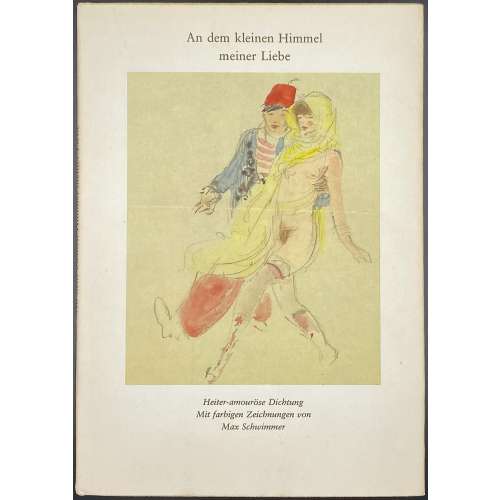 Description: bound in light yellow cloth with red and orange geometrical design to front cover and black lettering to spine, in pictorial DJ “An dem kleinen Himmel | meiner Liebe | {colour vignette} | Heiter-amouröse Dichtung | Mit 24 farbigen Zeichnungen von | Max Schwimmer”; pp.: [1-6] 7-95 [96], total 48 leaves, with 22 offset colour full-page illustrations, DJ and title-page vignettes by Max Schwimmer; plates with pagination. Anthology of German love poetry from Caspar Stieler (1632 – 1707) to Wolfgang Tilgner (1932 – 2011). Title-page: An dem kleinen Himmel | meiner Liebe | Heiter-amouröse Dichtung | Mit 24 farbigen Zeichnungen | von Max Schwimmer | {vignette} | Verlag der Nation | Berlin || Contributors: Bruno Brandl (German, fl. c. 1969 – 1991)– editor. Max Schwimmer (German, 1895 – 1960) – artist. VEB Druckhaus “Maxim Gorki” (Altenburg) – printer. Verlag der Nation (Berlin) – publisher.
Description: bound in light yellow cloth with red and orange geometrical design to front cover and black lettering to spine, in pictorial DJ “An dem kleinen Himmel | meiner Liebe | {colour vignette} | Heiter-amouröse Dichtung | Mit 24 farbigen Zeichnungen von | Max Schwimmer”; pp.: [1-6] 7-95 [96], total 48 leaves, with 22 offset colour full-page illustrations, DJ and title-page vignettes by Max Schwimmer; plates with pagination. Anthology of German love poetry from Caspar Stieler (1632 – 1707) to Wolfgang Tilgner (1932 – 2011). Title-page: An dem kleinen Himmel | meiner Liebe | Heiter-amouröse Dichtung | Mit 24 farbigen Zeichnungen | von Max Schwimmer | {vignette} | Verlag der Nation | Berlin || Contributors: Bruno Brandl (German, fl. c. 1969 – 1991)– editor. Max Schwimmer (German, 1895 – 1960) – artist. VEB Druckhaus “Maxim Gorki” (Altenburg) – printer. Verlag der Nation (Berlin) – publisher. -
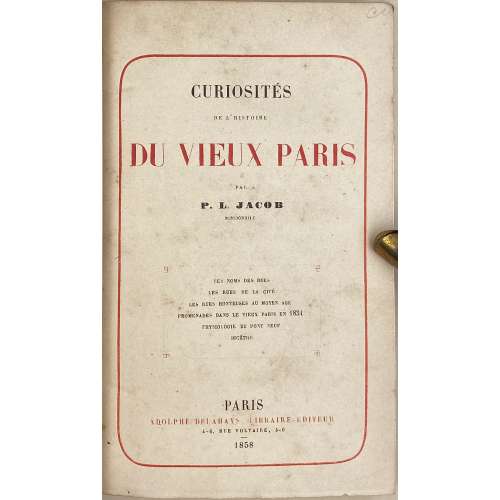 Title-page: CURIOSITÉS | DE L’HISTOIRE | DU VIEUX PARIS | PAR | P. L. JACOB | BIBLIOPHILE | { LES NOMS DES RUES | LES RUES DE CITÉ | LES RUES HONTEUSES AU MOYEN AGE. | PROMENADES DANS LE VIEUX PARIS EN 1834. | PHYSIOLOGIE DU PONT NEUF. | BICÊTRE } | PARIS | ADOLPHE DELAHAYS, LIBRAIRE-ÉDITEUR | 4-6, RUE VOLTAIRE, 4-6 | – | 1858 || Description: Hardcover, in-16o, 17 x 11 cm, quarter brown morocco over marbled boards, spine with raised bands, gilt lettering, gilt fleurons, marbled endpapers, original wrappers with red and black lettering within red frame bound in, some pages uncut. Collation: 8vo; π2 14, 2-238 244, total 186 leaves between original wrappers. Pagination: [4] [1] 2-364 [4], total 372 pages. Catalogue raisonné: Vicar: I, 770. Contributors: Printer: Simon Raçon et Comp. (Paris). Author: Paul Lacroix [P. L. Jacob] (French, 1806 – 1884). Publisher: Adolphe Delahays (French, mid-19th century).
Title-page: CURIOSITÉS | DE L’HISTOIRE | DU VIEUX PARIS | PAR | P. L. JACOB | BIBLIOPHILE | { LES NOMS DES RUES | LES RUES DE CITÉ | LES RUES HONTEUSES AU MOYEN AGE. | PROMENADES DANS LE VIEUX PARIS EN 1834. | PHYSIOLOGIE DU PONT NEUF. | BICÊTRE } | PARIS | ADOLPHE DELAHAYS, LIBRAIRE-ÉDITEUR | 4-6, RUE VOLTAIRE, 4-6 | – | 1858 || Description: Hardcover, in-16o, 17 x 11 cm, quarter brown morocco over marbled boards, spine with raised bands, gilt lettering, gilt fleurons, marbled endpapers, original wrappers with red and black lettering within red frame bound in, some pages uncut. Collation: 8vo; π2 14, 2-238 244, total 186 leaves between original wrappers. Pagination: [4] [1] 2-364 [4], total 372 pages. Catalogue raisonné: Vicar: I, 770. Contributors: Printer: Simon Raçon et Comp. (Paris). Author: Paul Lacroix [P. L. Jacob] (French, 1806 – 1884). Publisher: Adolphe Delahays (French, mid-19th century). -
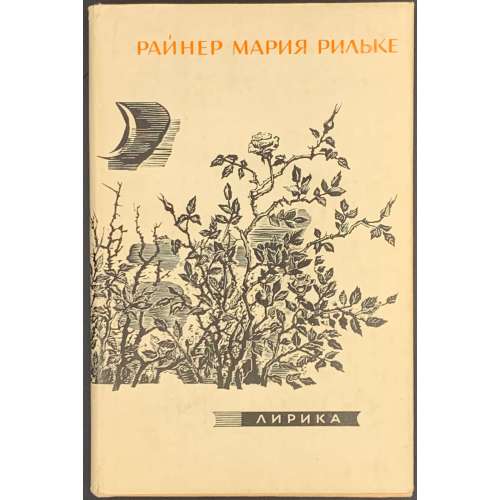 Small volume 17 x 11.5 cm, bound in tan cloth with brown lettering to front cover and spine, gilt fillets to spine, in wood-engraved pictorial dust jacket; pp.: [1-4] 5-254 [2], total 256 pages; collated in-16mo: [1]-816, total 128 leaves; wood-engraved portrait frontispiece within collation. Print run: 35,000 copies. Title-page (red and black): Райнер Мария Рильке | ЛИРИКА | Перевод с немецкого | Т. Сильман | {publisher’s device} | Издательство «Художественная литература» | Москва • 1956 • Ленинград || Contributors: Rainer Maria Rilke (German, 1875 – 1926) Тамара Исааковна Сильман (Russian-Jewish, 1909 – 1974) Владимир Григорьевич Адмони (Russian-Jewish, 1909 – 1993)
Small volume 17 x 11.5 cm, bound in tan cloth with brown lettering to front cover and spine, gilt fillets to spine, in wood-engraved pictorial dust jacket; pp.: [1-4] 5-254 [2], total 256 pages; collated in-16mo: [1]-816, total 128 leaves; wood-engraved portrait frontispiece within collation. Print run: 35,000 copies. Title-page (red and black): Райнер Мария Рильке | ЛИРИКА | Перевод с немецкого | Т. Сильман | {publisher’s device} | Издательство «Художественная литература» | Москва • 1956 • Ленинград || Contributors: Rainer Maria Rilke (German, 1875 – 1926) Тамара Исааковна Сильман (Russian-Jewish, 1909 – 1974) Владимир Григорьевич Адмони (Russian-Jewish, 1909 – 1993) -
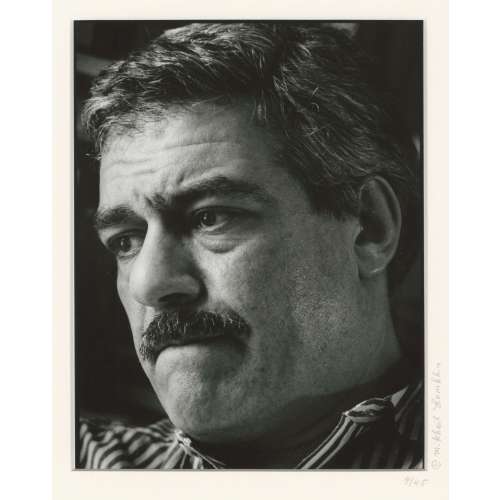 Photographic portrait of writer Andrei Sinyavsky, head and shoulder, turned to the left, wearing glasses. Pencil-signed on the mat: 4/45 • ©Mikhail Lemkhin; on the back of the print: Copyright statement stamp; ink stamp ©MIKHAIL LEMKHIN; ink stamp: PHOTO BY MIKHAIL LEMKHIN | 1811 38TH AVENUE | SAN FRANCISCO, CA 94122 | (415) 664-7677; pencil inscription on the back of the mat: (top) АНДРЕЙ СИНЯВСКИЙ | ANDREI SINYAVSKY, (bottom) XXIX. Size: mat: 43.2 x 35.5 cm; window: 23.5 x 18.5 cm; print: 25.2 x 20.2 cm. Limited edition of 45, of which this is № 4, signed and stamped by the artist. Sitter: Sergei Dovlatov [Сергей Донатович Довлатов] (Russian, 1941 – 1990)
Photographic portrait of writer Andrei Sinyavsky, head and shoulder, turned to the left, wearing glasses. Pencil-signed on the mat: 4/45 • ©Mikhail Lemkhin; on the back of the print: Copyright statement stamp; ink stamp ©MIKHAIL LEMKHIN; ink stamp: PHOTO BY MIKHAIL LEMKHIN | 1811 38TH AVENUE | SAN FRANCISCO, CA 94122 | (415) 664-7677; pencil inscription on the back of the mat: (top) АНДРЕЙ СИНЯВСКИЙ | ANDREI SINYAVSKY, (bottom) XXIX. Size: mat: 43.2 x 35.5 cm; window: 23.5 x 18.5 cm; print: 25.2 x 20.2 cm. Limited edition of 45, of which this is № 4, signed and stamped by the artist. Sitter: Sergei Dovlatov [Сергей Донатович Довлатов] (Russian, 1941 – 1990) -
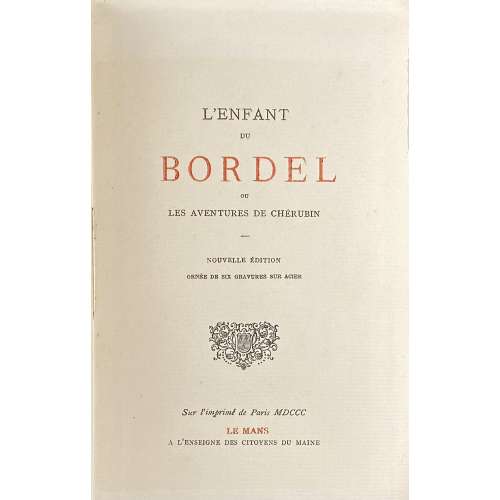 Softcover volume, 17.5 x 11 cm, in-12, brown wrappers without lettering, text printed on laid paper, six plates on India paper barbarously glued in, pp.: fep, [4] (h.t. t.p.), [1-3] 4-182, fep. Title-page (red and black): L’ENFANT | DU | BORDEL | OU | LES AVENTURES DE CHÉRUBIN | – | NOUVELLE ÉDITION | ORNÉE DE SIX GRAVURES SUR ACIER | {fleuron} | Sur l’imprimé de Paris MDCCC | LE MANS | A L’ENSEIGNE DES CITOYENS DU MAINE || Catalogue raisonné: Dutel I: A-325; Pia 395: 222 pages (we have 182 as per Dutel), attributes publication to Poulet-Malassis, 1866. Catalogue Poulet-Malassis & ses amis description: № 82.[PIGAULT-LEBRUN]. L’Enfant du Bordel, ou Les Aventures de Chérubin, nouvelle édition, ornée de six gravures sur acier. Sur l’imprimé de Paris, MDCCC, Le Mans, à l’enseigne des citoyens du Maine. [A. Christiaens, 1875 ?]. In-12, broché. 2 .n.ch., 182 pages, 1 f. blanc, couverture muette en papier vieux orange. Illustré de 6 figures hors-texte sur acier. Bibliographie : G* 553 (40 frs), Dutel A-325. Contributors: Guillaume Charles Antoine Pigault de l'Espinoy [Pigault-Lebrun] (French, 1753 – 1835) – author. Alexis Christiaens (Belgian, d. 1880) – publisher.
Softcover volume, 17.5 x 11 cm, in-12, brown wrappers without lettering, text printed on laid paper, six plates on India paper barbarously glued in, pp.: fep, [4] (h.t. t.p.), [1-3] 4-182, fep. Title-page (red and black): L’ENFANT | DU | BORDEL | OU | LES AVENTURES DE CHÉRUBIN | – | NOUVELLE ÉDITION | ORNÉE DE SIX GRAVURES SUR ACIER | {fleuron} | Sur l’imprimé de Paris MDCCC | LE MANS | A L’ENSEIGNE DES CITOYENS DU MAINE || Catalogue raisonné: Dutel I: A-325; Pia 395: 222 pages (we have 182 as per Dutel), attributes publication to Poulet-Malassis, 1866. Catalogue Poulet-Malassis & ses amis description: № 82.[PIGAULT-LEBRUN]. L’Enfant du Bordel, ou Les Aventures de Chérubin, nouvelle édition, ornée de six gravures sur acier. Sur l’imprimé de Paris, MDCCC, Le Mans, à l’enseigne des citoyens du Maine. [A. Christiaens, 1875 ?]. In-12, broché. 2 .n.ch., 182 pages, 1 f. blanc, couverture muette en papier vieux orange. Illustré de 6 figures hors-texte sur acier. Bibliographie : G* 553 (40 frs), Dutel A-325. Contributors: Guillaume Charles Antoine Pigault de l'Espinoy [Pigault-Lebrun] (French, 1753 – 1835) – author. Alexis Christiaens (Belgian, d. 1880) – publisher. -
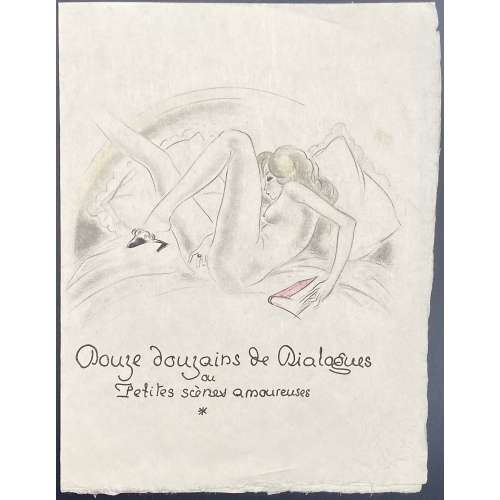 Description: An unbound softcover volume 23 x 18 cm, collated as 17 gatherings in 4to, text in fac-simile manuscript printed on Japon Nacre wove paper with untrimmed outer and bottom margins, with engraved title-page and 11 laid-in hand-coloured etchings after André Collot; in red quarter morocco over marbled boards folder with gilt lettering to spine “P. L. | ~ | PETITES | SCÈNES | AMOUREUSES”, in a matching slipcase 25 x 20 cm. Complete copy with all the pages, incl. the limitation page. Title-page: {vignette in colour} | Douze douzains de Dialogues | ou | Petites scènes amoureuses | * || (text in fac-simile ms). Limitation: Cet ouvrage a été tiré | sure Japn supernacré | à 100 exemplaire | numerotés de I à C | EXEMPLAIRE № LII. Content: (97 dialogues, not 144), similar to Pia: Premier douzain : Dialogues des Filles nues (1, 3, 4, 5, 6) – 5 dialogues; Deuxième douzain : Dialogue[s] des Masturbées (13, 14, 15, 16, 17, 18, 19, 20, [21]) – 9 dialogues; Troisième douzain : Dialogues des Masturbées (25, 26, 27, [28], 29, 30, 31, 32, 33) – 9 dialogues; Quatrième douzain : Dialogues des Lécheuses (37, 38, 39, 40, 41, 42, 44) – 7 dialogues; Cinquième douzain : Dialogues des Phallophores (49, 50, 51, 52, 53, 54) – 6 dialogues; Sixième douzain : Dialogues des Goules (61, 62, 63, 64, 65, 65 (i.e. 66), 67, 68, 69, 70, 71) – 11 dialogues; Septième douzain : Dialogues des Amoureuses (73, 74, 75, 76, 77, 78, 79, [80]) – 8 dialogues; Huitième douzain : Dialogues des Enculées (85, 86, 87, 88, 89, 90, 91, 92, 93, 94, [95]) – 11 dialogues; Neuvième douzain : Dialogues des Chieuses (97, 98, 99, 100, 101, 102, 104) – 7 dialogues; Dixième douzain : Dialogues des Pisseuses (109, 110, 111, 112, 114) – 5 dialogues; Onzième douzain : Dialogues des Mères (121, 122, 123, 124, 125, 126, 127, 128, 129, 130, 131, 132) – 12 dialogues; Douzième douzain : Dialogues des Enfants (134, 135, 136, 137, 138, 139, [140]) – 7 dialogues. Collation: [1]-[17]4; total 68 leaves plus 11 plates. See another copy of the same book in this collection [LIB-2819.2021], where 13 (blank/limitation) is missing. Edition: This copy of "calligraphié" Douze douzains de dialogues ou petites scènes amoureuses was most probably published in Paris by Libraire Robert Télin in 1927, 100 copies on Japon Nacre as per Dutel (1920-1970) № 1427. This is a complete copy with all 68 leaves; LIB-2819.2021 has 67 leaves. Another "calligraphié" edition published in c. 1940 (Dutel 1429) is bound and has 80 leaves. Dutel unequivocally attributes the drawings to André Collot. Plates in this copy are similar to the ones in a pirated copy of Scènes de péripatéticiennes / Douze douzains de dialogues [LIB-2961.2022] (Dutel № 2366). According to Pia (1978) № 358, this is a 1927 edition published in Paris by libraire Robert Télin: « 1 f. blanc, 1 f. (justification), 1 f. (titre) et 65 ff. n. ch., plus 11 gravures à l’eau-forte rehaussées de couleurs ». Edition limited to 100 copies numbered I – C; this copy is № LII (52). Catalogue raisonné: Dutel (1920-1970) №№ 1427 and 1429, p. 137 and № 2366, p. 356 ; Pia (1978) 358-9, p. 199-200. Contributors: Pierre Louÿs (French, 1870 – 1925) – author. André Collot (French, 1897 – 1976) – artist.
Description: An unbound softcover volume 23 x 18 cm, collated as 17 gatherings in 4to, text in fac-simile manuscript printed on Japon Nacre wove paper with untrimmed outer and bottom margins, with engraved title-page and 11 laid-in hand-coloured etchings after André Collot; in red quarter morocco over marbled boards folder with gilt lettering to spine “P. L. | ~ | PETITES | SCÈNES | AMOUREUSES”, in a matching slipcase 25 x 20 cm. Complete copy with all the pages, incl. the limitation page. Title-page: {vignette in colour} | Douze douzains de Dialogues | ou | Petites scènes amoureuses | * || (text in fac-simile ms). Limitation: Cet ouvrage a été tiré | sure Japn supernacré | à 100 exemplaire | numerotés de I à C | EXEMPLAIRE № LII. Content: (97 dialogues, not 144), similar to Pia: Premier douzain : Dialogues des Filles nues (1, 3, 4, 5, 6) – 5 dialogues; Deuxième douzain : Dialogue[s] des Masturbées (13, 14, 15, 16, 17, 18, 19, 20, [21]) – 9 dialogues; Troisième douzain : Dialogues des Masturbées (25, 26, 27, [28], 29, 30, 31, 32, 33) – 9 dialogues; Quatrième douzain : Dialogues des Lécheuses (37, 38, 39, 40, 41, 42, 44) – 7 dialogues; Cinquième douzain : Dialogues des Phallophores (49, 50, 51, 52, 53, 54) – 6 dialogues; Sixième douzain : Dialogues des Goules (61, 62, 63, 64, 65, 65 (i.e. 66), 67, 68, 69, 70, 71) – 11 dialogues; Septième douzain : Dialogues des Amoureuses (73, 74, 75, 76, 77, 78, 79, [80]) – 8 dialogues; Huitième douzain : Dialogues des Enculées (85, 86, 87, 88, 89, 90, 91, 92, 93, 94, [95]) – 11 dialogues; Neuvième douzain : Dialogues des Chieuses (97, 98, 99, 100, 101, 102, 104) – 7 dialogues; Dixième douzain : Dialogues des Pisseuses (109, 110, 111, 112, 114) – 5 dialogues; Onzième douzain : Dialogues des Mères (121, 122, 123, 124, 125, 126, 127, 128, 129, 130, 131, 132) – 12 dialogues; Douzième douzain : Dialogues des Enfants (134, 135, 136, 137, 138, 139, [140]) – 7 dialogues. Collation: [1]-[17]4; total 68 leaves plus 11 plates. See another copy of the same book in this collection [LIB-2819.2021], where 13 (blank/limitation) is missing. Edition: This copy of "calligraphié" Douze douzains de dialogues ou petites scènes amoureuses was most probably published in Paris by Libraire Robert Télin in 1927, 100 copies on Japon Nacre as per Dutel (1920-1970) № 1427. This is a complete copy with all 68 leaves; LIB-2819.2021 has 67 leaves. Another "calligraphié" edition published in c. 1940 (Dutel 1429) is bound and has 80 leaves. Dutel unequivocally attributes the drawings to André Collot. Plates in this copy are similar to the ones in a pirated copy of Scènes de péripatéticiennes / Douze douzains de dialogues [LIB-2961.2022] (Dutel № 2366). According to Pia (1978) № 358, this is a 1927 edition published in Paris by libraire Robert Télin: « 1 f. blanc, 1 f. (justification), 1 f. (titre) et 65 ff. n. ch., plus 11 gravures à l’eau-forte rehaussées de couleurs ». Edition limited to 100 copies numbered I – C; this copy is № LII (52). Catalogue raisonné: Dutel (1920-1970) №№ 1427 and 1429, p. 137 and № 2366, p. 356 ; Pia (1978) 358-9, p. 199-200. Contributors: Pierre Louÿs (French, 1870 – 1925) – author. André Collot (French, 1897 – 1976) – artist. -
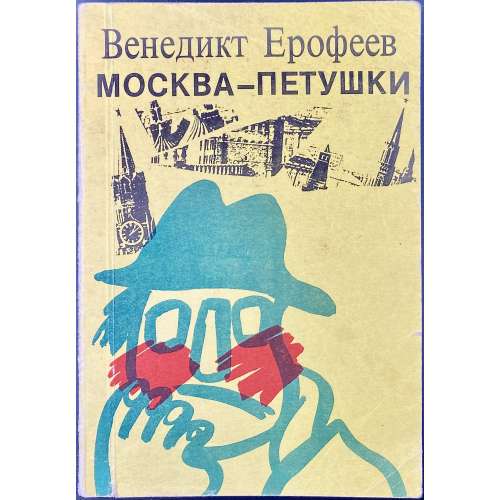 Paperback, 17.2 x 12 cm, yellow pictorial wrappers, lettering to front, back, and spine; pp.: [1-4] 5-137 [5]. Title-page: ВЕНЕДИКТ | ЕРОФЕЕВ | МОСКВА — ПЕТУШКИ | ПОВЕСТЬ | Таллинн | “Александра” | 1990 || Print-run: 30,000. Contributors: Венедикт Васильевич Ерофеев [Venedikt Yerofeyev] (Russian, 1938 – 1990) – author.
Paperback, 17.2 x 12 cm, yellow pictorial wrappers, lettering to front, back, and spine; pp.: [1-4] 5-137 [5]. Title-page: ВЕНЕДИКТ | ЕРОФЕЕВ | МОСКВА — ПЕТУШКИ | ПОВЕСТЬ | Таллинн | “Александра” | 1990 || Print-run: 30,000. Contributors: Венедикт Васильевич Ерофеев [Venedikt Yerofeyev] (Russian, 1938 – 1990) – author. -
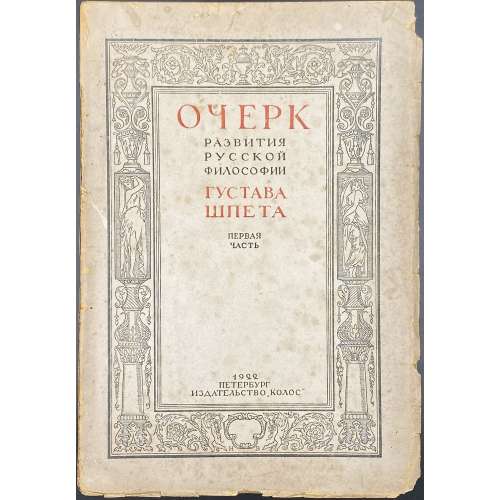 Paperback, 25 x 17 cm, publisher’s wrappers with red and black lettering in a pictorial frame by Vysheslavstev; pp.: [i-vii] viii-xv [xvi blank], [1-5] 6-348 [4]; collated 8vo: π8 1-228, total 184 leaves, 368 pages; gatherings 1-22 uncut. Because the author was banned, lettering on the spine was covered by a glued strip of blank paper; only the year 1922 was left visible. Front wrapper: ОЧЕРК | РАЗВИТИЯ | РУССКОЙ | ФИЛОСОФИИ | ГУСТАВА | ШПЕТА | ПЕРВАЯ | ЧАСТЬ | 1922 | ПЕТЕРБУРГ | ИЗДАТЕЛЬСТВО “КОЛОС” || Title-page: similar lettering in black only with no frame. Design of the front wrapper and the publisher’s device (π1) by Николай Николаевич Вышеславцев [N. Vysheslavstev] (Russian, 1890 – 1952). Title: Sketch on the development of Russian philosophy, Part one. [Part two was never published]. Author: Густав Густавович Шпет [Gustav Shpet] (Russian, 1879 – 1937) – executed by fire squad on 16 November 1937.
Paperback, 25 x 17 cm, publisher’s wrappers with red and black lettering in a pictorial frame by Vysheslavstev; pp.: [i-vii] viii-xv [xvi blank], [1-5] 6-348 [4]; collated 8vo: π8 1-228, total 184 leaves, 368 pages; gatherings 1-22 uncut. Because the author was banned, lettering on the spine was covered by a glued strip of blank paper; only the year 1922 was left visible. Front wrapper: ОЧЕРК | РАЗВИТИЯ | РУССКОЙ | ФИЛОСОФИИ | ГУСТАВА | ШПЕТА | ПЕРВАЯ | ЧАСТЬ | 1922 | ПЕТЕРБУРГ | ИЗДАТЕЛЬСТВО “КОЛОС” || Title-page: similar lettering in black only with no frame. Design of the front wrapper and the publisher’s device (π1) by Николай Николаевич Вышеславцев [N. Vysheslavstev] (Russian, 1890 – 1952). Title: Sketch on the development of Russian philosophy, Part one. [Part two was never published]. Author: Густав Густавович Шпет [Gustav Shpet] (Russian, 1879 – 1937) – executed by fire squad on 16 November 1937. -
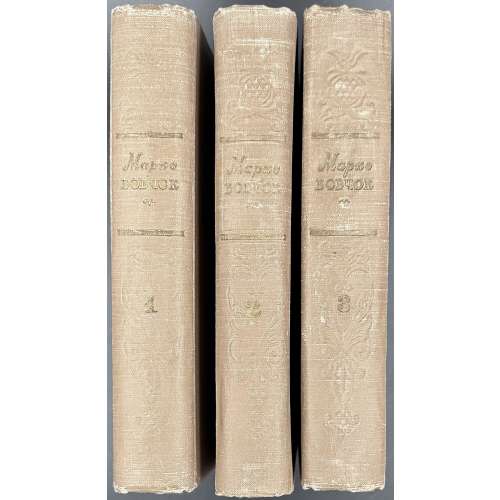 Three 8vo volumes, 20.8 x 13.8 cm each, uniformly bound in brown cloth with gilt lettering and embossed design to front and spine; v. 1: [1-4] 5-537 [3], total 540 pages plus frontispiece, two-colour woodcut portrait, by Ivan Nikolaevtsev; v. 2: [1-6] 7-537 [3], total 540 pages; v. 3: [1-6] 7-620 [4], total 624 pages. Waterstain throughout the third volume. Title-page (red and black): Марко Вовчок | СОБРАНИЕ СОЧИНЕНИЙ | ТОМ ПЕРВЫЙ (ВТОРОЙ, ТРЕТИЙ) | {fleuron} | ИЗДАТЕЛЬСТВО «ИЗВЕСТИЯ» | Москва | 1957 || Opposite t.p. (red and black): Марко Вовчок | СОБРАНИЕ СОЧИНЕНИЙ | В ТРЕХ | ТОМАХ | {fleuron} | ИЗДАТЕЛЬСТВО «ИЗВЕСТИЯ» | Москва | 1957 || Half-title (red and black): БИБЛИОТЕКА КЛАССИКОВ | ЛИТЕРАТУР | НАРОДОВ СССР | | {fleuron} || Imprint: Вступительная статья А. Белецкого. Подготовка текста и примечания С. Машинского. Print run: 30,000 copies. Contributors: Марко Вовчок [Marko Vovchok; Марія Олександрівна Вілінська] (Ukrainian, 1833 – 1907) – author. Other variants: Markowovzok and Marko Vovtchok. Олександр Іванович Білецький [Александр Иванович Белецкий] (Ukrainian, 1884 – 1961) – author/preface. Семен Иосифович Машинский (Ukrainian, 1914-1978) – author/editing and comments. Иван Григорьевич Николаевцев (Ukrainian, 1902–1960) – artist.
Three 8vo volumes, 20.8 x 13.8 cm each, uniformly bound in brown cloth with gilt lettering and embossed design to front and spine; v. 1: [1-4] 5-537 [3], total 540 pages plus frontispiece, two-colour woodcut portrait, by Ivan Nikolaevtsev; v. 2: [1-6] 7-537 [3], total 540 pages; v. 3: [1-6] 7-620 [4], total 624 pages. Waterstain throughout the third volume. Title-page (red and black): Марко Вовчок | СОБРАНИЕ СОЧИНЕНИЙ | ТОМ ПЕРВЫЙ (ВТОРОЙ, ТРЕТИЙ) | {fleuron} | ИЗДАТЕЛЬСТВО «ИЗВЕСТИЯ» | Москва | 1957 || Opposite t.p. (red and black): Марко Вовчок | СОБРАНИЕ СОЧИНЕНИЙ | В ТРЕХ | ТОМАХ | {fleuron} | ИЗДАТЕЛЬСТВО «ИЗВЕСТИЯ» | Москва | 1957 || Half-title (red and black): БИБЛИОТЕКА КЛАССИКОВ | ЛИТЕРАТУР | НАРОДОВ СССР | | {fleuron} || Imprint: Вступительная статья А. Белецкого. Подготовка текста и примечания С. Машинского. Print run: 30,000 copies. Contributors: Марко Вовчок [Marko Vovchok; Марія Олександрівна Вілінська] (Ukrainian, 1833 – 1907) – author. Other variants: Markowovzok and Marko Vovtchok. Олександр Іванович Білецький [Александр Иванович Белецкий] (Ukrainian, 1884 – 1961) – author/preface. Семен Иосифович Машинский (Ukrainian, 1914-1978) – author/editing and comments. Иван Григорьевич Николаевцев (Ukrainian, 1902–1960) – artist. -
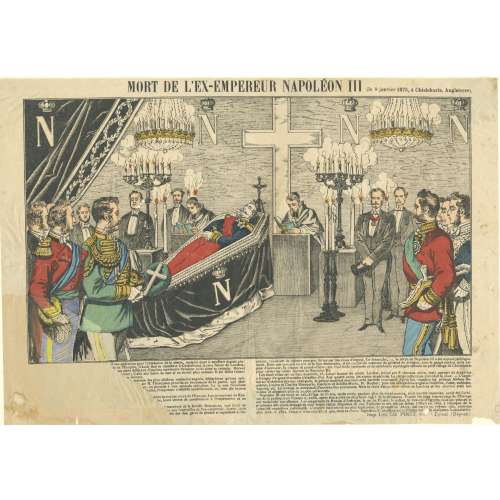 Hand-coloured woodcut on wove paper, 270 x 380 mm; attached to the sheet 303 x 442 mm with pencil ms inscription to the top left corner on the reverse: “Haye le 2-3-75”. Top: "MORT DE L'EX-EMPEREUR NAPOLÉON III (le 9 janvier 1873, à Chislehurts [sic], Angleterre)." Bottom right: "Imp. Lith. CH. PINOT, éditeur. Épinal (Dépose)". Bottom left corner of the image sheet torn and manually restored. Text partially lost, starting with « d’une opération pour l’extraction de la pierre, maladie dont’ il souffrait depuis plu-… ». See Chislehurst. Charles-François Pinot (French, 1817 – 1879) – publisher/printer.
Hand-coloured woodcut on wove paper, 270 x 380 mm; attached to the sheet 303 x 442 mm with pencil ms inscription to the top left corner on the reverse: “Haye le 2-3-75”. Top: "MORT DE L'EX-EMPEREUR NAPOLÉON III (le 9 janvier 1873, à Chislehurts [sic], Angleterre)." Bottom right: "Imp. Lith. CH. PINOT, éditeur. Épinal (Dépose)". Bottom left corner of the image sheet torn and manually restored. Text partially lost, starting with « d’une opération pour l’extraction de la pierre, maladie dont’ il souffrait depuis plu-… ». See Chislehurst. Charles-François Pinot (French, 1817 – 1879) – publisher/printer. -
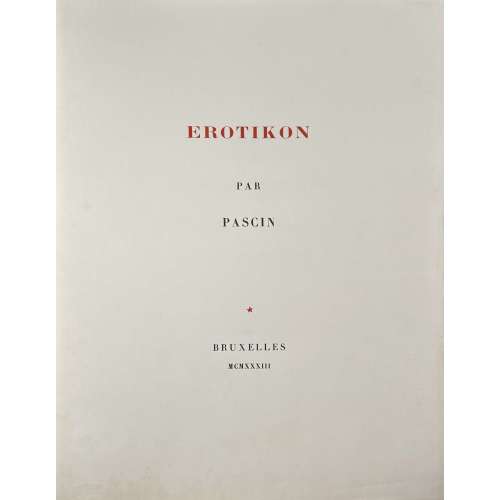 A portfolio of nine heliogravures after Jules Pascin. Cloth-backed cardboard portfolio 420 x 335 mm with 9 heliogravures on slightly tinted india paper, each numbered in pencil and mounted into a passe-partout 410 x 318 mm. Copy № 25 out of 40 printed on india (chine) paper. Copy № 25 of 40. Title (red and black): EROTIKON | PAR | PASCIN | ★ | BRUXELLES | MCMXXXIII || Limitation: CET | ALBUM | A ÉTÉ TIRÉ | A | QUARANTE ET UN EXEMPLAIRES | NUMÉROTÉS | DONT | UN EX. SUR PAPIER ANCIEN | & | QUARANTE EX. SUR CHINE | No (ms 25/40) || Catalogue raisonné: Dutel III № 1498. Seller's description:Neun Heliogravüren. 1933. Meist ca. 30 : 35 cm. Nummeriert. Exemplar 25/40 (Gesamtauflage 41). – Die Heliogravüren auf leicht getöntem China, jedes Blatt mit Bleistift nummeriert und in Passepartouts montiert. – Die neun Passepartouts eingelegt in zwei Büttenumschläge, einer mit Titel und dem nummerierten Auflagenvermerk, der zweite unbedruckt, ferner Büttenumschlag mit Titel in Rotdruck und Halbleinenchemise. – Die Heliogravüren erschienen 1933, drei Jahre nach Pascins Tod bei Daragnes in Paris mit der fingierten Angabe »Brüssel«. – Das berühmte Mappenwerk bildet eine der großen Seltenheiten der erotischen Kunst. Die Motive Pascins beschreibt das Bilderlexikon als »eine Art ›Boheme-Rokoko im Montmartre-Milieu‹« und lobt den Künstler: »Er ist ein außerordentlicher Zeichner, der es versteht, bei allem Zynismus, der seinen exhibitionistischen Charakter nicht verleugnet, auf diesem Kulturdünger eine neuartige Blume voll graziöser Schönheit erblühen zu lassen.« Mappe: 42 : 33,5 cm. – Der äußere Büttenumschlag mit leichtem Wasserrand. – Zwei Heliogravüren minimal stockfleckig, sonst tadellos und absolut vollständig. Dutel 1498 (mit Auflagenvarianten). – Der kalte Blick S. 198ff. – Bilderlexikon II, 718.
A portfolio of nine heliogravures after Jules Pascin. Cloth-backed cardboard portfolio 420 x 335 mm with 9 heliogravures on slightly tinted india paper, each numbered in pencil and mounted into a passe-partout 410 x 318 mm. Copy № 25 out of 40 printed on india (chine) paper. Copy № 25 of 40. Title (red and black): EROTIKON | PAR | PASCIN | ★ | BRUXELLES | MCMXXXIII || Limitation: CET | ALBUM | A ÉTÉ TIRÉ | A | QUARANTE ET UN EXEMPLAIRES | NUMÉROTÉS | DONT | UN EX. SUR PAPIER ANCIEN | & | QUARANTE EX. SUR CHINE | No (ms 25/40) || Catalogue raisonné: Dutel III № 1498. Seller's description:Neun Heliogravüren. 1933. Meist ca. 30 : 35 cm. Nummeriert. Exemplar 25/40 (Gesamtauflage 41). – Die Heliogravüren auf leicht getöntem China, jedes Blatt mit Bleistift nummeriert und in Passepartouts montiert. – Die neun Passepartouts eingelegt in zwei Büttenumschläge, einer mit Titel und dem nummerierten Auflagenvermerk, der zweite unbedruckt, ferner Büttenumschlag mit Titel in Rotdruck und Halbleinenchemise. – Die Heliogravüren erschienen 1933, drei Jahre nach Pascins Tod bei Daragnes in Paris mit der fingierten Angabe »Brüssel«. – Das berühmte Mappenwerk bildet eine der großen Seltenheiten der erotischen Kunst. Die Motive Pascins beschreibt das Bilderlexikon als »eine Art ›Boheme-Rokoko im Montmartre-Milieu‹« und lobt den Künstler: »Er ist ein außerordentlicher Zeichner, der es versteht, bei allem Zynismus, der seinen exhibitionistischen Charakter nicht verleugnet, auf diesem Kulturdünger eine neuartige Blume voll graziöser Schönheit erblühen zu lassen.« Mappe: 42 : 33,5 cm. – Der äußere Büttenumschlag mit leichtem Wasserrand. – Zwei Heliogravüren minimal stockfleckig, sonst tadellos und absolut vollständig. Dutel 1498 (mit Auflagenvarianten). – Der kalte Blick S. 198ff. – Bilderlexikon II, 718. -
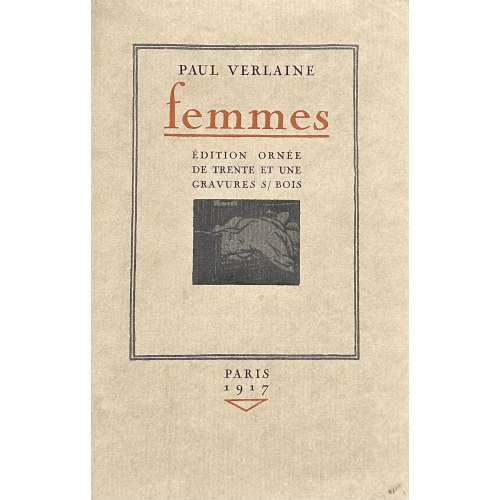 Softcover, 258 x 166 mm, publisher’s olive French flapped wrappers in owner’s glassine dustcover, edges untrimmed, some pages uncut, printed on thick wove paper with watermark “Hollande van Gelder Zonen”, in a slipcase. Pp.: [1-10] 11-129 [5], pages in wrappers included in the count, total 67 leaves; two-tone woodcuts by Jean-Gabriel Daragnès within the pagination. Title-page (red and black, in a double-fillet frame): PAUL VERLAINE | femmes | ÉDITION ORNÉE | DE TRENTE ET UNE | GRAVURES S/ BOIS | {vignette} | (under the bottom frame) PARIS | 1917 | {red triangle} || Limitation: Il a été tiré de cet ouvrage : 11 15 Exemplaires sur vieux papier de Japon numérotés de I à XV; 15 20 Exemplaires sur papier de Chine numérotés de XVI à XXXV; auxquels on a joint une suite des fumés sur même papier. 250 Exemplaires sur papier vélin de Hollande Van Gelder Zonen numérotés de 1 à 250. Après le tirage les bois ont été détruits. № 1. Numbers “15” and “20” corrected manually by Daragnès (per Dutel). This is copy № 1 of vélin de Hollande print run. Catalogue raisonné: Dutel II: № 295; Nordmann II № 544. Seller’s description: Un volume broché in-8° sous couverture illustrée et rempliée. Etui cartonné. Illustré de 31 gravures sur bois en camaïeu, attribuées à DARAGNES, la plupart très libres, dont 18 à pleine page. Tiré à [226 ou 285] ex. numérotés. 1 des [200 ou 250] sur Hollande Van Gelder Zonen. Le nôtre porte le n°1. (Dutel : 295. Pia : 501. Carteret : IV, 392 : Belle édition rare, très estimée ». Monod : 11086). Dorgelès commenta ainsi ces illustrations : « Dans ces nus voluptueux et tragiques, qui semblent à la fois s’aimer et se haïr, on retrouve la même frénésie amère qui tourmente les poèmes interdits de Verlaine » (in Catalogue de livres... Daragnès, Drouot 1924, n°55). Très rares rousseurs. TRES BON EXEMPLAIRE, toujours recherché. Contributors: Paul Verlaine (French, 1844 – 1896) – author. Jean-Gabriel Daragnès (French, 1886 – 1950) – artist/publisher.
Softcover, 258 x 166 mm, publisher’s olive French flapped wrappers in owner’s glassine dustcover, edges untrimmed, some pages uncut, printed on thick wove paper with watermark “Hollande van Gelder Zonen”, in a slipcase. Pp.: [1-10] 11-129 [5], pages in wrappers included in the count, total 67 leaves; two-tone woodcuts by Jean-Gabriel Daragnès within the pagination. Title-page (red and black, in a double-fillet frame): PAUL VERLAINE | femmes | ÉDITION ORNÉE | DE TRENTE ET UNE | GRAVURES S/ BOIS | {vignette} | (under the bottom frame) PARIS | 1917 | {red triangle} || Limitation: Il a été tiré de cet ouvrage : 11 15 Exemplaires sur vieux papier de Japon numérotés de I à XV; 15 20 Exemplaires sur papier de Chine numérotés de XVI à XXXV; auxquels on a joint une suite des fumés sur même papier. 250 Exemplaires sur papier vélin de Hollande Van Gelder Zonen numérotés de 1 à 250. Après le tirage les bois ont été détruits. № 1. Numbers “15” and “20” corrected manually by Daragnès (per Dutel). This is copy № 1 of vélin de Hollande print run. Catalogue raisonné: Dutel II: № 295; Nordmann II № 544. Seller’s description: Un volume broché in-8° sous couverture illustrée et rempliée. Etui cartonné. Illustré de 31 gravures sur bois en camaïeu, attribuées à DARAGNES, la plupart très libres, dont 18 à pleine page. Tiré à [226 ou 285] ex. numérotés. 1 des [200 ou 250] sur Hollande Van Gelder Zonen. Le nôtre porte le n°1. (Dutel : 295. Pia : 501. Carteret : IV, 392 : Belle édition rare, très estimée ». Monod : 11086). Dorgelès commenta ainsi ces illustrations : « Dans ces nus voluptueux et tragiques, qui semblent à la fois s’aimer et se haïr, on retrouve la même frénésie amère qui tourmente les poèmes interdits de Verlaine » (in Catalogue de livres... Daragnès, Drouot 1924, n°55). Très rares rousseurs. TRES BON EXEMPLAIRE, toujours recherché. Contributors: Paul Verlaine (French, 1844 – 1896) – author. Jean-Gabriel Daragnès (French, 1886 – 1950) – artist/publisher. -
 Iron tsuba of quatrefoil form with design of bamboo stems and leaves, and a plank bridge in openwork (sukashi). Hitsu-ana of irregular form. Iron with smooth chocolate patina. Copper and shakudō sekigane. This piece is illustrated in Sasano: Japanese Sword Guard Masterpieces from the Sasano Collection, 1994 on page 295 under № 254 with the following description:
Iron tsuba of quatrefoil form with design of bamboo stems and leaves, and a plank bridge in openwork (sukashi). Hitsu-ana of irregular form. Iron with smooth chocolate patina. Copper and shakudō sekigane. This piece is illustrated in Sasano: Japanese Sword Guard Masterpieces from the Sasano Collection, 1994 on page 295 under № 254 with the following description:Nishigaki. First generation Kanshiro (died in the sixth year of Genroku, 1693, at the age of 81). Sukashi design: Bamboo (take). Early Edo period, late 17th century (Kanbun / Enppo era). Height: 72.6 mm; Width: 71.5 mm; Rim thickness: .6 mm; Centre thickness: 5.1 mm. Rounded rim. The shape of this sword guard is a quatrefoil and the design is arranged in the form of a saddle flap. Two bamboo trunks with leaves comprise the design. Calm, soothing and sophisticated are the features of this artist in his later years. Such characteristics may remind one of the work of the first Hikozo.
Provenance: Sasano Masayuki collection, № 254. What is interesting, and what had been found by Bruce Kirkpatrick, is that in the earlier photograph of the same piece ['Sukashi tsuba - bushido no bi' by Sasano Masayuki, photography by Fujimoto Shihara, 1972 (in Japanese), page 245, №201] we clearly see kebori - linear carving that decorates the bamboo leaves and the planks of the bridge. The said kebori have totally disappeared between 1972 and 1994. The tsuba became absolutely flat! Now we can only speculate about the reasons for such cruel treatment of the artistically and historically important item.
Sukashi tsuba - bushido no bi. Author: Sasano Masayuki, photography: Fujimoto Shihara, 1972 (in Japanese). Page 245, №201.
-

Гоббс Томас. Левиафан или материя, форма и власть государства церковного и гражданского. Предисловие и редакция А. Ческиса. - М.-Л.: Гос.соц.-эконом.из-во (СОЦЭКГИЗ), 1936. - 504 стр.
Тираж 10 000 экз.
Библиотека материализма. Томас Гоббс (1588-1679)ю
-
 Utagawa Toyokuni (歌川豐國); 1769 – 24 February 1825. The kabuki actors Ichikawa Danzo IV as Jiroemon (in draw cape) and Morita Kanya VIII as Buemon. Play 'Oriai Tsuzure no Nishiki', performed at the Moritaza Theater in the 7th month of 1798. Publisher: Eijudo.
Utagawa Toyokuni (歌川豐國); 1769 – 24 February 1825. The kabuki actors Ichikawa Danzo IV as Jiroemon (in draw cape) and Morita Kanya VIII as Buemon. Play 'Oriai Tsuzure no Nishiki', performed at the Moritaza Theater in the 7th month of 1798. Publisher: Eijudo. -
 Iron tsuba of round form decorated with two boar's eyes (inome) and two dragonflies (tombo) in small openwork (ko-sukashi) outlined with brass wire. The plate also decorated with 2 to 5 concentric circular rows of brass dots (nail heads) in ten-zōgan. Center of the plate outlined with the inlaid circular brass wire. The inlaid metal is of red-ish hue, so it may be copper, and not brass. The surface has remnants of lacquer. Ōnin school. Mid Muromachi period, middle of 15th century. Dimensions: Diameter: 90 mm, thickness: 3.2 mm. Notes regarding design: "According to various sources, the dragonfly (tombo) is emblematic of martial success, as various names for the insect are homophones for words meaning "victory". The dragonfly is also auspicious because references in the Kojiki and Nihongi link it in both name and shape to the old kingdom of Yamato." [Merrily Baird. Symbols of Japan. Thematic motifs in art and design. Rizzoli international publications, Inc., 2001, p. 108]. "The dragonfly (tonbo), was also called kachimushi in earlier times, and due to the auspicious literal meaning "victory bug" of the characters of this word it became a popular theme on sword fittings." [Iron tsuba. The works of the exhibition "Kurogane no hana", The Japanese Sword Museum, 2014, p. 13]. Two other cutouts - in the form of what in European tradition symbolizes the heart, on the top and in the bottom of tsuba disc - may have two different explanations. The most usual one, inome - "Heart-shaped pattern, which is said to go back to the shape of a wild boar's eye" [Markus Sesko. Encyclopedia of Japanese Swords. Print and publishing: Lulu Enterprises, Inc., 2014.]. This understanding is shared by Robert Haynes [Robert E. Haynes. Study Collection of Japanese Sword Fittings. Nihon Art Publishers, 2010.] and elsewhere, with an exception of Okabe-Kakuya [Okabe-Kakuya. JAPANESE SWORD GUARDS. Museum of Fine Arts, Boston. In cooperation with the department of Chinese and Japanese art; - 1908, p. 14], who provides the illustration of inome-shaped cut-outs with the following explanation: " The tsuba shown in Fig. 13 approaches a square form with rounded corners and is perforated with Aoi decoration. But this book was written long time ago, when people even at MFA might not know enough...
Iron tsuba of round form decorated with two boar's eyes (inome) and two dragonflies (tombo) in small openwork (ko-sukashi) outlined with brass wire. The plate also decorated with 2 to 5 concentric circular rows of brass dots (nail heads) in ten-zōgan. Center of the plate outlined with the inlaid circular brass wire. The inlaid metal is of red-ish hue, so it may be copper, and not brass. The surface has remnants of lacquer. Ōnin school. Mid Muromachi period, middle of 15th century. Dimensions: Diameter: 90 mm, thickness: 3.2 mm. Notes regarding design: "According to various sources, the dragonfly (tombo) is emblematic of martial success, as various names for the insect are homophones for words meaning "victory". The dragonfly is also auspicious because references in the Kojiki and Nihongi link it in both name and shape to the old kingdom of Yamato." [Merrily Baird. Symbols of Japan. Thematic motifs in art and design. Rizzoli international publications, Inc., 2001, p. 108]. "The dragonfly (tonbo), was also called kachimushi in earlier times, and due to the auspicious literal meaning "victory bug" of the characters of this word it became a popular theme on sword fittings." [Iron tsuba. The works of the exhibition "Kurogane no hana", The Japanese Sword Museum, 2014, p. 13]. Two other cutouts - in the form of what in European tradition symbolizes the heart, on the top and in the bottom of tsuba disc - may have two different explanations. The most usual one, inome - "Heart-shaped pattern, which is said to go back to the shape of a wild boar's eye" [Markus Sesko. Encyclopedia of Japanese Swords. Print and publishing: Lulu Enterprises, Inc., 2014.]. This understanding is shared by Robert Haynes [Robert E. Haynes. Study Collection of Japanese Sword Fittings. Nihon Art Publishers, 2010.] and elsewhere, with an exception of Okabe-Kakuya [Okabe-Kakuya. JAPANESE SWORD GUARDS. Museum of Fine Arts, Boston. In cooperation with the department of Chinese and Japanese art; - 1908, p. 14], who provides the illustration of inome-shaped cut-outs with the following explanation: " The tsuba shown in Fig. 13 approaches a square form with rounded corners and is perforated with Aoi decoration. But this book was written long time ago, when people even at MFA might not know enough... The same interpretation of the said heart-like symbol (aoi leaf) is given at Helen C. Gunsaulus. Japanese sword-mounts in the collection of Field Museum. // Publication 216, Anthropological Series, Volume XVI; Chicago, 1923; p. 54: "This mokkō-formed tsuba recalls the aoi form, perforated as it is with the four aoi leaves." It is possible that the "wild boar's eye" theory was developed by later scholars.
The same interpretation of the said heart-like symbol (aoi leaf) is given at Helen C. Gunsaulus. Japanese sword-mounts in the collection of Field Museum. // Publication 216, Anthropological Series, Volume XVI; Chicago, 1923; p. 54: "This mokkō-formed tsuba recalls the aoi form, perforated as it is with the four aoi leaves." It is possible that the "wild boar's eye" theory was developed by later scholars.
 There is also a theory, supported by Graham Gemmell, saying that: “In simple terms Onin works are decorated Ko-Katchushi tsuba. … But, not content with iron alone, they began to decorate it with what was, in the early Muromachi period, a rare and valuable metal, brass. The Onin workers cut the design into the iron, using narrow channels, cast the brass, piece by piece, and then hammered it into the iron plate as though they were putting together a jigsaw. When complete the tsuba would be black lacquered exactly as the plain iron ones had been, the brass shining dully through it in a way that fulfilled the goal of shibui or restrained elegance.” [Tosogu. Treasure of the samurai. Fine Japanese Sword Fittings from The Muromachi to The Meiji Period, by Graham Gemmell. // Sarzi-Amadè Limited, London, 1991. An exhibition held in London from 21st March to 4th April, 1991]. The following illustration from Helen C. Gunsaulus. Japanese sword-mounts in the collection of Field Museum. // Publication 216, Anthropological Series, Volume XVI; Chicago, 1923; pp. 43 supports the idea.
There is also a theory, supported by Graham Gemmell, saying that: “In simple terms Onin works are decorated Ko-Katchushi tsuba. … But, not content with iron alone, they began to decorate it with what was, in the early Muromachi period, a rare and valuable metal, brass. The Onin workers cut the design into the iron, using narrow channels, cast the brass, piece by piece, and then hammered it into the iron plate as though they were putting together a jigsaw. When complete the tsuba would be black lacquered exactly as the plain iron ones had been, the brass shining dully through it in a way that fulfilled the goal of shibui or restrained elegance.” [Tosogu. Treasure of the samurai. Fine Japanese Sword Fittings from The Muromachi to The Meiji Period, by Graham Gemmell. // Sarzi-Amadè Limited, London, 1991. An exhibition held in London from 21st March to 4th April, 1991]. The following illustration from Helen C. Gunsaulus. Japanese sword-mounts in the collection of Field Museum. // Publication 216, Anthropological Series, Volume XVI; Chicago, 1923; pp. 43 supports the idea.
 Helen C. Gunsaulus' description of the dragonfly emblem is as follows: "This motive, the dragon-fly (akitsu), is generally accepted as a symbol of the kingdom of Japan, and the origin of the idea is traced to the legend recounted in the Kojiki and Nihongo of the Emperor Jimmu's view of the island from mountain top. He is said to have thought the kingdom looked like a dragon-fly touching its tail with its mouth. From this it received its name Akitsu-shima... etc."
Helen C. Gunsaulus' description of the dragonfly emblem is as follows: "This motive, the dragon-fly (akitsu), is generally accepted as a symbol of the kingdom of Japan, and the origin of the idea is traced to the legend recounted in the Kojiki and Nihongo of the Emperor Jimmu's view of the island from mountain top. He is said to have thought the kingdom looked like a dragon-fly touching its tail with its mouth. From this it received its name Akitsu-shima... etc."
-
 Shimizu-Jingo tsuba with a dragon and vajra (on reverse) motif. Unsigned. Possibly, 3rd or 4th master of Shimizu-Jingo family in Higo province. Iron. Low relief carving. Edo period, 1700's. Height: 75.4 mm, Width: 72.2 mm, Thickness at seppa-dai: 4.0 mm
Shimizu-Jingo tsuba with a dragon and vajra (on reverse) motif. Unsigned. Possibly, 3rd or 4th master of Shimizu-Jingo family in Higo province. Iron. Low relief carving. Edo period, 1700's. Height: 75.4 mm, Width: 72.2 mm, Thickness at seppa-dai: 4.0 mm



